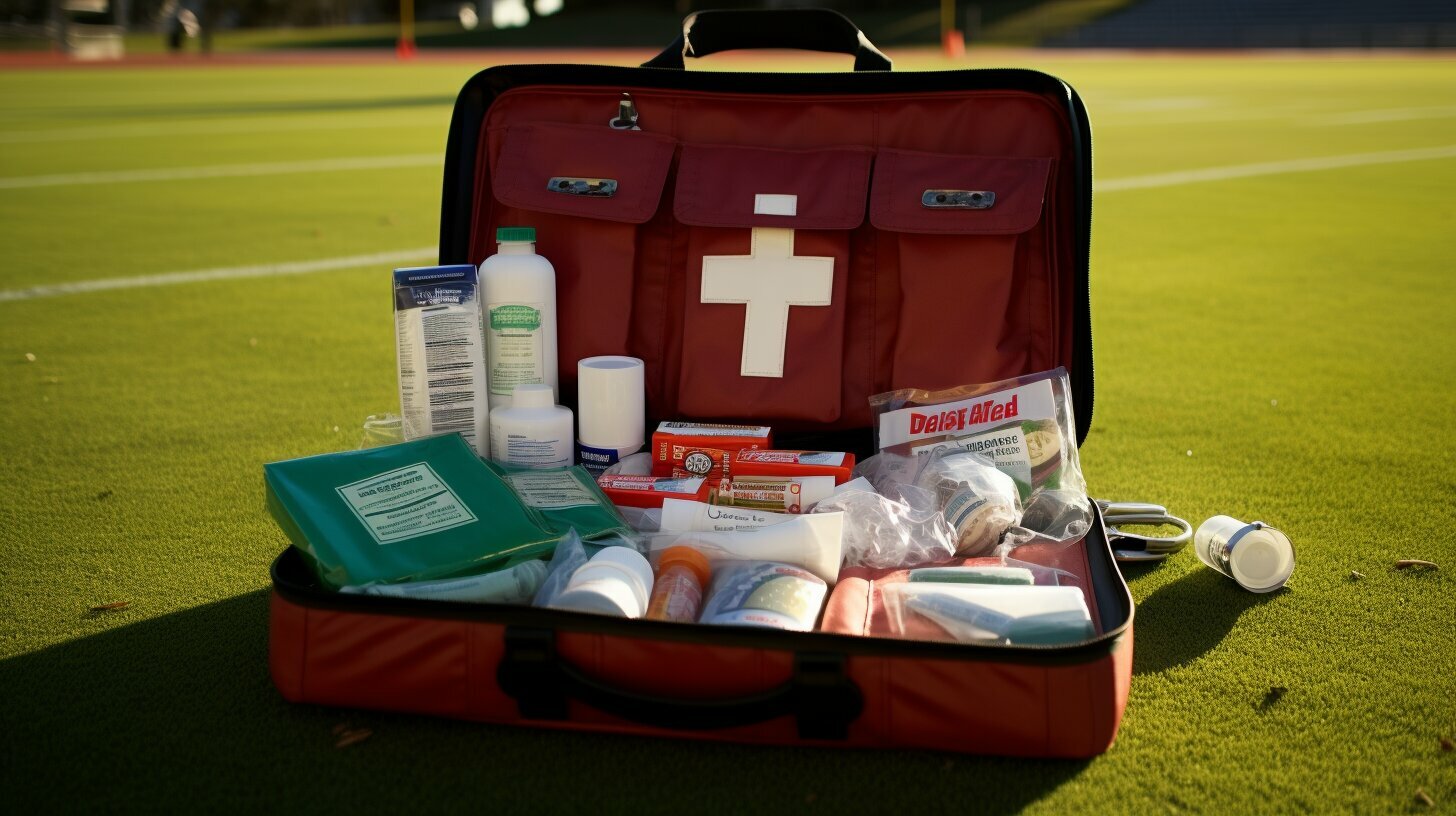When it comes to football, having a well-equipped first aid kit is essential for ensuring the safety and well-being of players, but it’s important to tailor it accordingly for different scenarios such as training and match day.
In a training environment, coaches should have their own first aid kit stocked with essential items. This includes band-aids in various sizes, cardboard splints, elastic wraps, athletic tape, gauze pads, hydrogen peroxide, isopropyl alcohol, instant ice packs, latex gloves, and more. It is also crucial to have players’ medical information/history and emergency medical service numbers readily available.
On match day, a comprehensive sports first aid kit is necessary to handle potential injuries on the field. This should include adhesive bandages, gauze, tape, elastic bandages, cold packs, antiseptic wipes, scissors, gloves, a CPR mask, and pain relievers. Being prepared with these items can make a significant difference in providing immediate care.
Regular maintenance and replenishment of the first aid kit are also vital. It is essential to check the kit frequently, ensuring all items are in date and properly stocked to handle any situation that may arise.
Furthermore, injury prevention education is crucial in reducing the need for extensive first aid treatment. Educating yourself and your team on common injuries and preventive measures can go a long way in ensuring the well-being of all players.
Lastly, customizing the first aid kit based on the specific needs of your team and the sport you coach is important. Take into account any unique requirements and tailor the kit accordingly.
Remember, the kit should always include essential items like band-aids and splints, which prove helpful in treating minor injuries and providing temporary support for fractures or sprains.
To ensure quick treatment on the field, it is crucial to have items such as adhesive bandages, gauze, tape, and cold packs readily available in the first aid kit.
Hygiene and safety should also be prioritized, and the inclusion of items like antiseptic wipes and gloves can help prevent infections and maintain a safe environment during treatment.
Lastly, having emergency medical service numbers readily available in the first aid kit is essential. Immediate access to professional assistance is crucial in case of severe injuries during training or match day.
In a training environment, it’s crucial to have a first aid kit that is well-stocked with essential items to handle minor injuries and emergencies. These items ensure that players can receive immediate care when needed, promoting their safety and well-being.
Here are some key items that should be included in a first aid kit for training sessions:
- Band-aids in various sizes to cover cuts and abrasions.
- Cardboard splints to provide temporary support for fractures or sprains.
- Elastic wraps to secure splints and dressings in place.
- Athletic tape for additional support and stability.
- Gauze pads to control bleeding and cover wounds.
- Hydrogen peroxide and isopropyl alcohol to clean wounds and prevent infection.
- Instant ice packs to reduce swelling and pain.
- Latex gloves to protect against cross-contamination.
- Medical information/history forms for each player, including any allergies or pre-existing conditions.
It’s also important to have emergency medical service numbers readily available in case of severe injuries. This allows for immediate access to professional assistance when needed. By being well-prepared with a properly stocked first aid kit, coaches can ensure the safety of their players during training sessions.
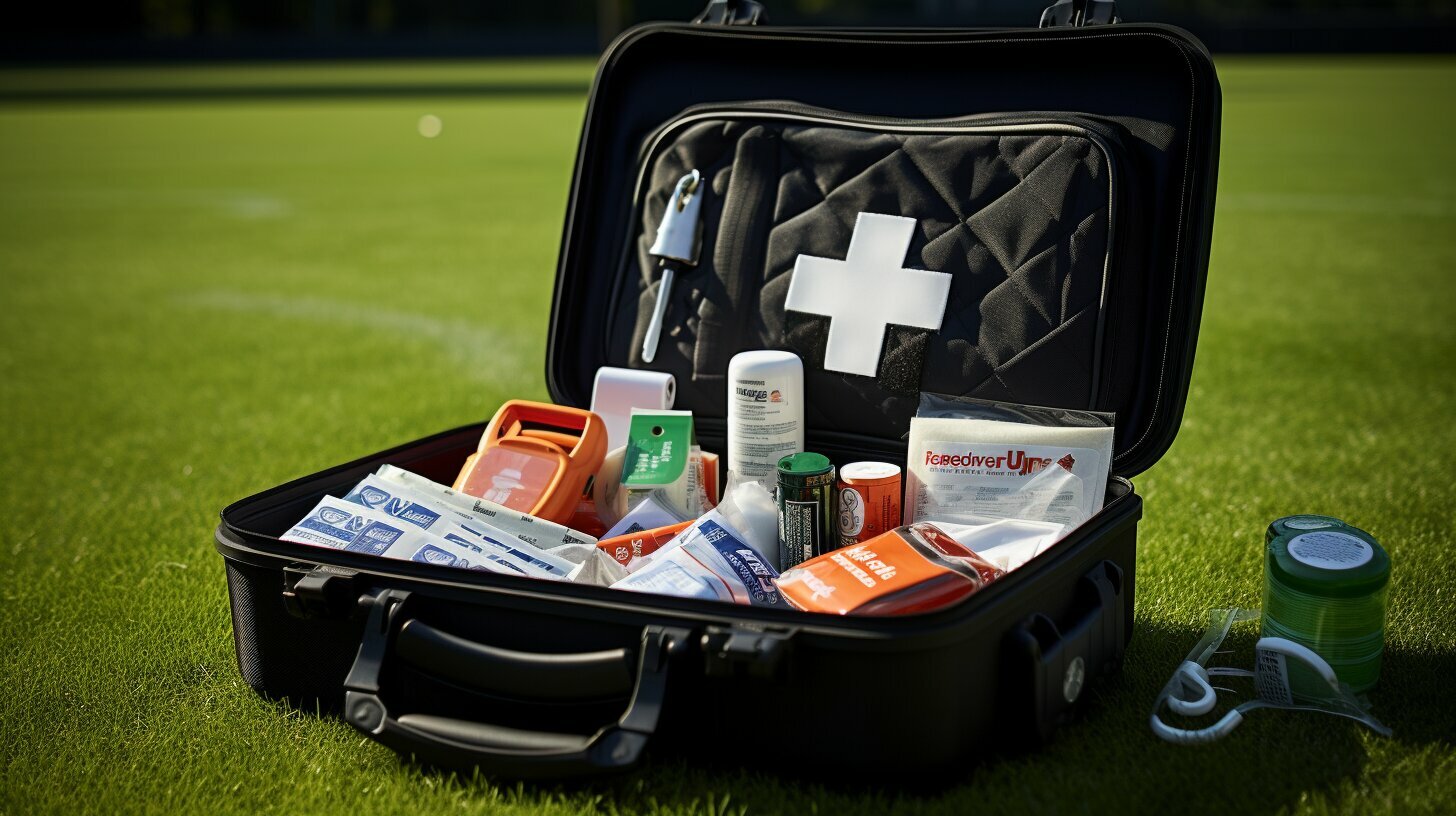
| Item | Function |
|---|---|
| Band-aids | To cover cuts and abrasions |
| Cardboard splints | To provide temporary support for fractures or sprains |
| Elastic wraps | To secure splints and dressings in place |
| Athletic tape | For additional support and stability |
| Gauze pads | To control bleeding and cover wounds |
| Hydrogen peroxide and isopropyl alcohol | To clean wounds and prevent infection |
| Instant ice packs | To reduce swelling and pain |
| Latex gloves | To protect against cross-contamination |
| Medical information/history forms | For each player, including any allergies or pre-existing conditions |
The First Aid Kit for Match Day
On match day, a comprehensive first aid kit tailored specifically for sports is crucial to ensure prompt and effective treatment of any injuries that may occur. It is important to be prepared for various scenarios and have the necessary items readily available to provide immediate care to players.
Some essential items to include in your match day first aid kit are adhesive bandages of different sizes, gauze pads for cleaning and dressing wounds, and tape for securing bandages and dressings. Elastic bandages can provide support for sprains and strains, while cold packs can help reduce swelling and alleviate pain.
Antiseptic wipes are essential for cleaning wounds, and scissors and gloves are necessary for safe and hygienic treatment. A CPR mask should also be included in case of any respiratory emergencies. Additionally, pain relievers such as paracetamol or ibuprofen can help manage pain until further medical attention is available.
To visually summarize the contents of a comprehensive sports first aid kit for match day, here is a table:
| Item | Quantity |
|---|---|
| Adhesive bandages | Assorted sizes |
| Gauze pads | 10-12 |
| Tape | 1 roll |
| Elastic bandages | 2-3 |
| Cold packs | 2-4 |
| Antiseptic wipes | 10-12 |
| Scissors | 1 pair |
| Gloves | 2-3 pairs |
| CPR mask | 1 |
| Pain relievers | As needed |
Remember to regularly check and replenish the contents of your first aid kit to ensure that everything is up to date and readily available when needed. By customizing your kit based on the specific needs of your team and sport, you can provide the best possible care and ensure the safety of your players.
Regular Maintenance and Replenishment
To guarantee the effectiveness of your first aid kit, regular maintenance and replenishment of its contents is necessary. A well-stocked and up-to-date kit ensures that you are prepared for any situation that may arise on the football field. Here are some key points to consider when maintaining and replenishing your kit:
Check Expiration Dates
Take the time to carefully inspect each item in your first aid kit and check its expiration date. Medications, ointments, and other perishable items lose their effectiveness over time, so it is crucial to replace them before they expire. This ensures that you have access to the most effective treatment options when needed.
Restock Supplies
Regularly assess your first aid supplies and restock any items that have been used or are running low. This includes items such as band-aids, gauze pads, tape, and cold packs. It is also important to replenish any specialty items that may be specific to your team or sport. By keeping your first aid kit fully stocked, you can quickly and efficiently treat any injuries that occur.
Review and Update Emergency Numbers
Emergency medical service numbers and players’ medical information should be reviewed and updated regularly. Make sure that you have the correct contact information for medical professionals and emergency services in your area. Additionally, ensure that players’ medical information is current and readily available in case of an emergency. This can help medical personnel provide appropriate and timely care.
By regularly maintaining and replenishing your first aid kit, you are taking proactive steps to prioritize the safety and well-being of your players. A well-prepared kit, along with proper injury prevention education, can help mitigate potential risks and provide immediate care when needed. Remember to customize your kit based on the specific needs of your team and the sport you coach, ensuring that you are prepared for any football scenario that may arise.
Injury Prevention Education
Alongside a well-equipped first aid kit, educating yourself and your team on injury prevention plays a vital role in ensuring the overall safety of players. By promoting a culture of prevention, you can reduce the likelihood of on-field injuries and create a more secure environment for everyone involved in football.
Start by familiarizing yourself with common football injuries, such as sprains, strains, and fractures. Understanding the causes and risk factors can help you develop targeted strategies for prevention. Encourage your players to warm up properly before training or matches, emphasizing the importance of stretching and strengthening exercises to improve flexibility and muscular balance.
Additionally, educate your team on proper tackling and body positioning techniques to minimize the risk of collisions and impact-related injuries. Emphasize the importance of wearing appropriate protective gear, such as shin guards and mouthguards, to reduce the severity of injuries when accidents do occur.
Regularly conduct safety briefings or workshops to reinforce these preventive measures and address any questions or concerns your team may have. By staying informed and proactive, you can create a safer playing environment and reduce the need for extensive first aid treatment.
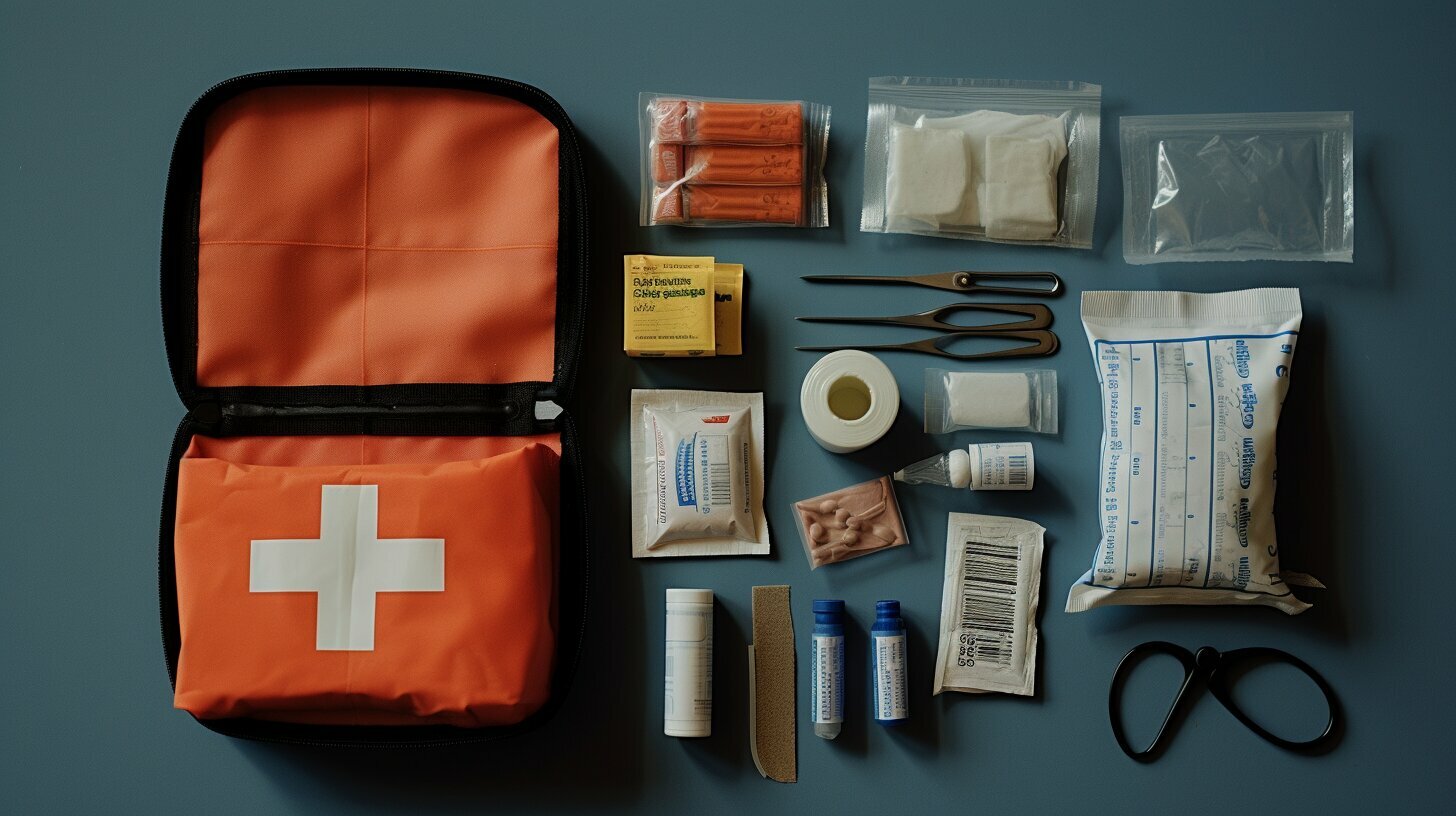
| Key Points: |
|---|
| 1. Familiarize yourself with common football injuries and their causes. |
| 2. Encourage proper warm-up exercises and stretching routines. |
| 3. Teach proper tackling and body positioning techniques. |
| 4. Emphasize the importance of wearing protective gear. |
| 5. Regularly conduct safety briefings and workshops. |
Customizing the Kit
Every team and sport may have its own specific needs, and as a coach, it’s crucial to customize your first aid kit accordingly. By tailoring the contents of the kit to the specific requirements of your team and the sport you coach, you can ensure that you are well-prepared for any potential injuries that may occur.
Consider the types of injuries that are common in your sport and include the necessary items to address those specific injuries. For example, if you coach a sport that involves a lot of cuts and scrapes, it’s important to have an ample supply of adhesive bandages in various sizes. Alternatively, if your sport involves a high risk of sprains or fractures, consider including sturdy cardboard splints to provide temporary support until medical help arrives.
In addition to considering the types of injuries that are common in your sport, it’s also important to think about the environment in which you will be coaching. If you frequently train or play matches in hot weather, be sure to include items such as sunscreen and electrolyte drinks to prevent heat-related illnesses. Likewise, if you coach a sport that involves contact or collision, it may be beneficial to have mouthguards and protective gear available in your first aid kit.

By customizing your first aid kit to meet the specific needs of your team and sport, you can ensure that you are well-prepared to handle any injuries or emergencies that may arise. Remember to regularly check and replenish the contents of your kit, as well as educate yourself and your team on injury prevention strategies. With a well-stocked and customized first aid kit, you can provide the best possible care for your players and promote their safety on and off the field.
Importance of Band-aids and Splints
Band-aids and splints are essential components of a first aid kit for football scenarios, as they cater to both minor injuries and potential fractures or sprains. Band-aids, available in various sizes, are ideal for covering small cuts and scrapes that commonly occur during training or matches. They help protect the wound from dirt and further injury, promoting quick healing.
When it comes to more serious injuries like fractures or sprains, splints play a crucial role in providing temporary support until proper medical attention can be sought. A cardboard splint, for example, can help stabilize a suspected fracture in a player’s arm or leg, minimizing movement and preventing further damage.
| Type of Injury | First Aid Component |
|---|---|
| Minor cuts and scrapes | Band-aids in various sizes |
| Potential fractures or sprains | Splints for temporary support |
It is crucial to have an ample supply of band-aids and splints in your first aid kit to address a wide range of injuries that may occur on the football field. By being prepared with these essential items, coaches and trainers can provide immediate care and support for players, aiding in their overall well-being and recovery.
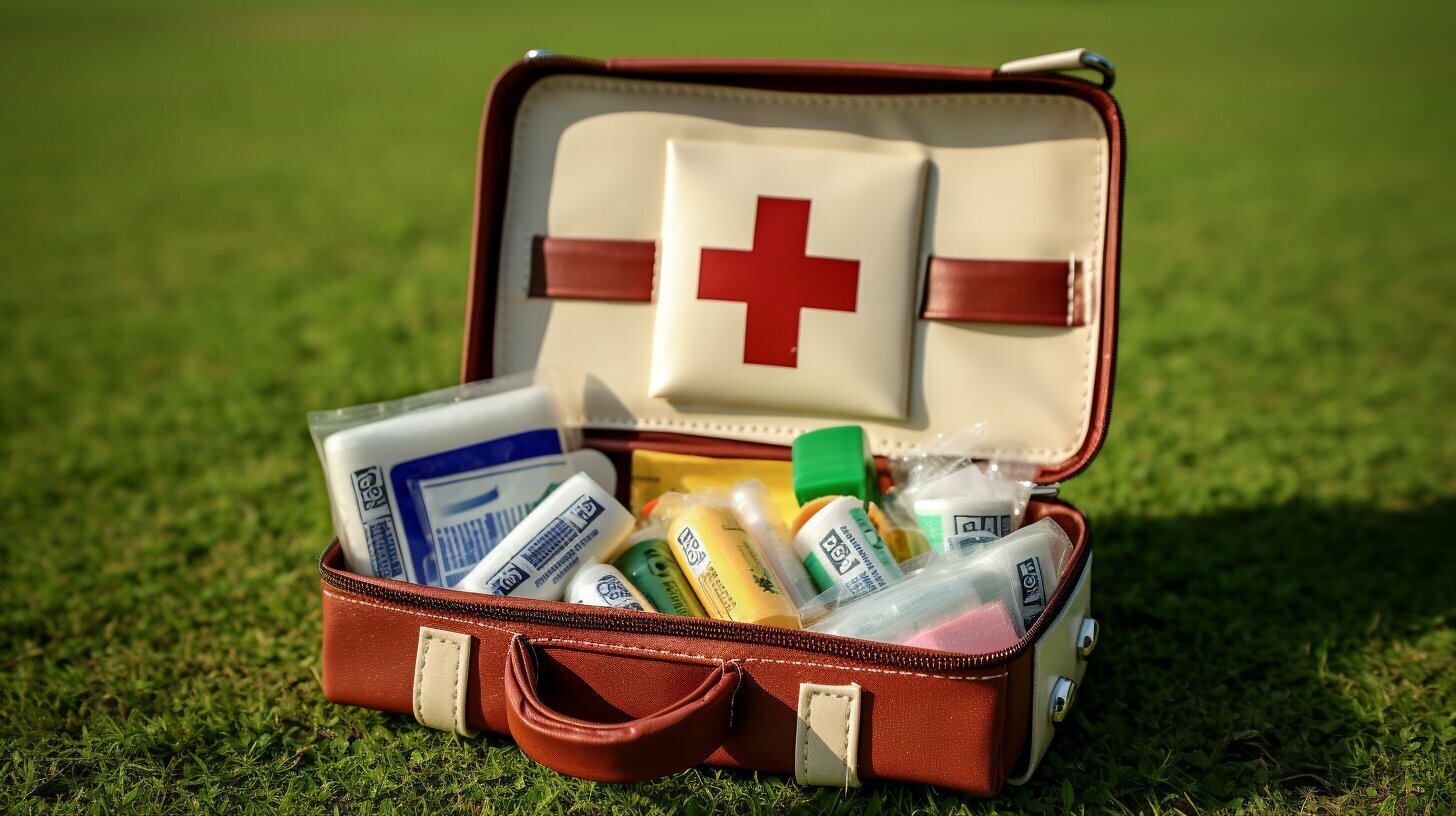
- Band-aids are necessary to cover small cuts and scrapes, protecting them from further injury and promoting healing.
- Splints provide temporary support for suspected fractures or sprains, minimizing movement and preventing additional damage.
- Having an ample supply of band-aids and splints in your first aid kit ensures prompt and effective treatment for various football-related injuries.
Remember, proper first aid management is essential for the safety and well-being of football players. By including band-aids and splints in your kit, you can be prepared to handle minor injuries and provide initial support for more severe conditions.
Essential Items for Quick Treatment
Quick treatment of injuries is crucial on match day, which is why having essential items in your first aid kit is paramount. These items can help provide immediate care and prevent further complications. Whether it’s a minor cut or a sprained ankle, having the right tools readily available can make a significant difference in the recovery time and overall well-being of your players.
Here are some essential items that should be included in your first aid kit for quick treatment:
- Adhesive bandages: These are essential for covering small cuts and abrasions, preventing dirt and bacteria from entering the wound.
- Gauze: Used to clean wounds and apply pressure to control bleeding.
- Tape: Medical tape helps secure dressings and provide support for sprains and strains.
- Elastic bandages: These are useful for providing compression and support for joint injuries.
- Cold packs: Instant ice packs can help reduce swelling and relieve pain after an injury.
In addition to these items, it’s important to have antiseptic wipes, scissors, gloves, a CPR mask, and pain relievers in your first aid kit. These items can help ensure proper hygiene, safety, and immediate care.
| Item | Use |
|---|---|
| Adhesive bandages | For covering small cuts and abrasions |
| Gauze | Used for cleaning wounds and applying pressure |
| Tape | Secure dressings and provide support for injuries |
| Elastic bandages | Provide compression and support for joint injuries |
| Cold packs | Reduce swelling and relieve pain |
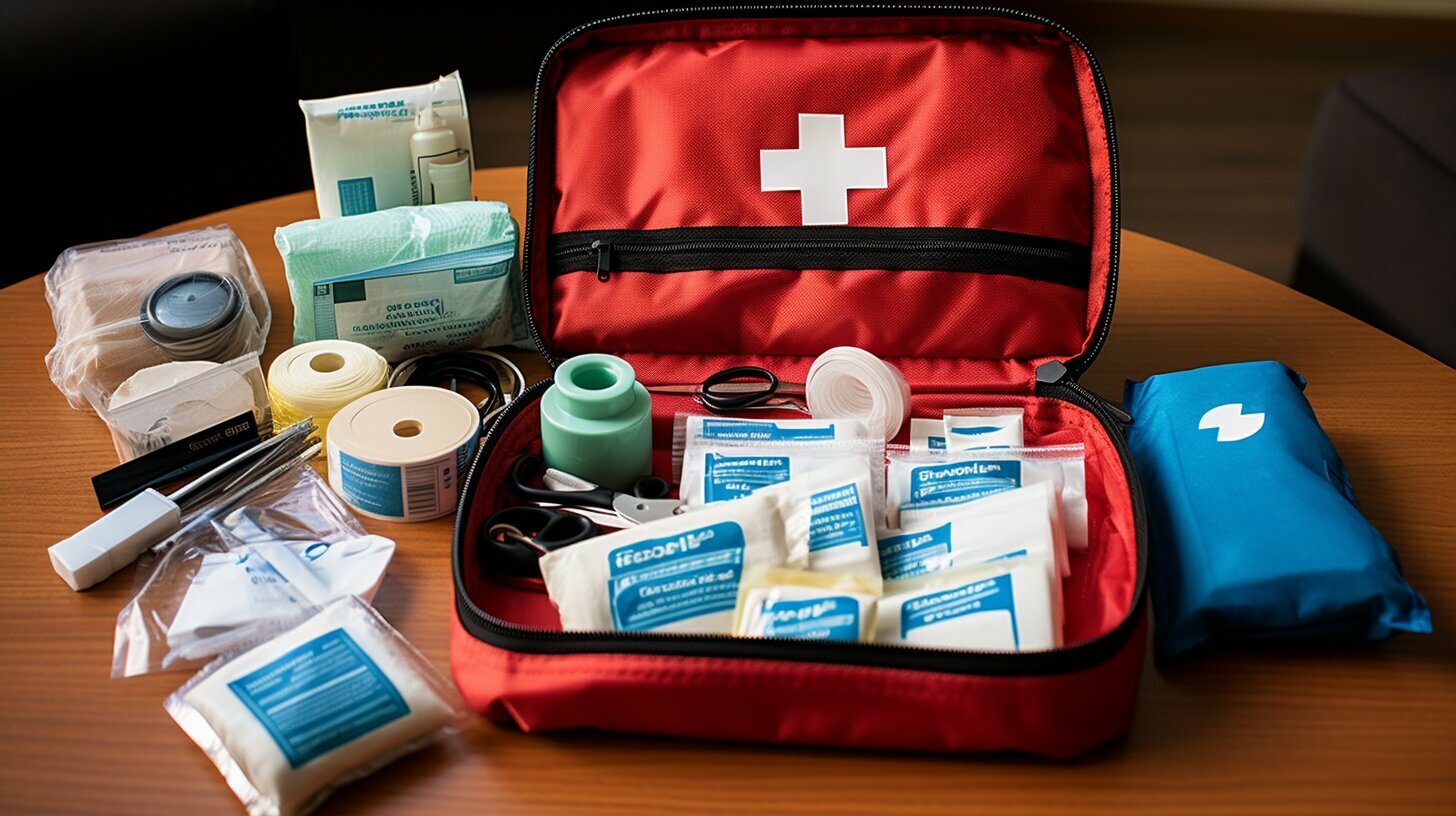
Remember, a well-stocked and well-maintained first aid kit is essential for ensuring the safety and well-being of your team. Regularly check and replenish the contents of your kit to ensure everything is up-to-date and readily available when needed. Additionally, educating yourself and your team on injury prevention can go a long way in reducing the need for extensive first aid treatment. Tailor your first aid kit to the specific needs of your team and the sport you coach, and be prepared for any situation that may arise on the field.
Ensuring Hygiene and Safety
Maintaining proper hygiene and safety should be a top priority when using a first aid kit, so be sure to include antiseptic wipes and gloves. These items are essential for preventing infections and creating a safe environment during treatment.
The antiseptic wipes can be used to clean wounds before applying any bandages or dressings. They help eliminate bacteria and reduce the risk of infection. Make sure to use the wipes as directed and dispose of them properly after use.
Gloves, on the other hand, provide a barrier between the person administering first aid and the injured player. They protect against potential bloodborne pathogens and help maintain a sterile environment. It is important to wear gloves when treating any open wounds, handling bodily fluids, or coming into contact with broken skin.
By including antiseptic wipes and gloves in your first aid kit, you are taking important steps towards ensuring the hygiene and safety of everyone involved. Remember to regularly check the expiration dates of these items and replenish them as needed.
| Benefits of Antiseptic Wipes: | Benefits of Gloves: |
|---|---|
| Eliminates bacteria | Offers barrier protection |
| Reduces risk of infection | Protects against bloodborne pathogens |
| Easy to use and dispose of | Maintains a sterile environment |

Importance of Emergency Medical Service Numbers
In case of any serious injuries during training or match day, having emergency medical service numbers readily available in your first aid kit is crucial. Whether it’s a sprained ankle, a broken bone, or a head injury, immediate access to professional assistance can make all the difference in ensuring the well-being of the players.
When constructing your first aid kit, make sure to include a prominent section with emergency medical service numbers for your area. This will ensure that you and your team have quick and easy access to the appropriate medical professionals who can provide the necessary care in case of an emergency.
Moreover, it’s essential to educate your team members on the importance of knowing these emergency numbers and how to use them effectively. Conduct regular drills and training sessions to familiarize everyone with the steps to take in case of an injury, including calling for emergency medical assistance.
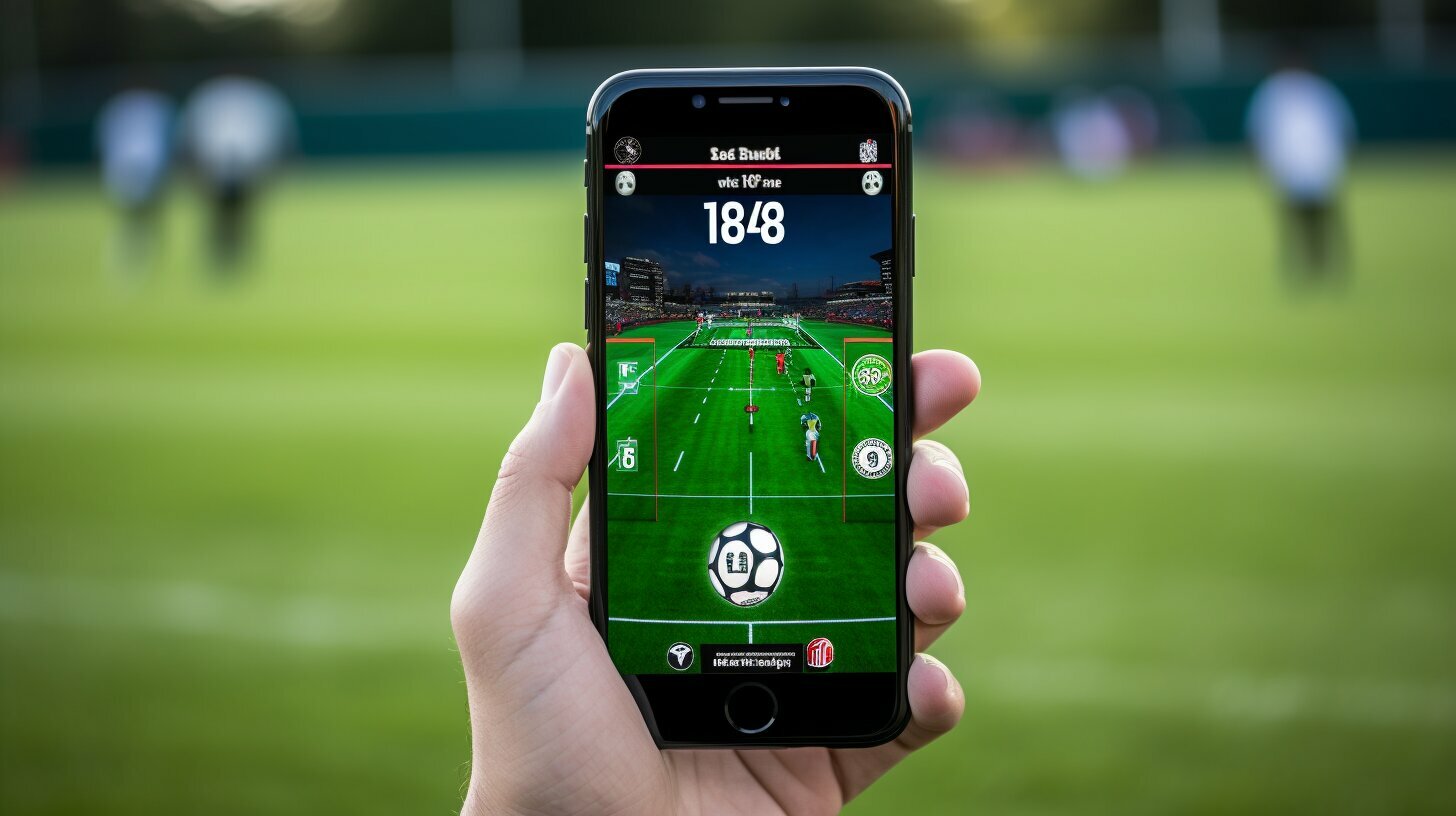
Remember, time is of the essence when it comes to handling injuries. The faster you can notify emergency medical services and get the injured player the help they need, the better their chances of recovery. Therefore, having the emergency medical service numbers readily available in your first aid kit is an essential step in ensuring the safety of your team.
| Emergency Medical Service Numbers | Area |
|---|---|
| Emergency Ambulance | 999 |
| Non-emergency Medical Helpline | 111 |
| Sports Injury Specialist | 123-456-789 |
Conclusion
Tailoring your first aid kit for different football scenarios, whether it’s training or match day, is crucial for ensuring the safety and well-being of players. Remember to customize your kit based on your team’s needs and always prioritize safety.
During training sessions, it’s important to have a well-stocked first aid kit that includes items such as band-aids in various sizes, cardboard splints, elastic wraps, athletic tape, gauze pads, hydrogen peroxide, isopropyl alcohol, instant ice packs, latex gloves, and more. Having players’ medical information/history and emergency medical service numbers readily available is also essential.
On match day, a comprehensive sports first aid kit is essential. It should include items like adhesive bandages, gauze, tape, elastic bandages, cold packs, antiseptic wipes, scissors, gloves, CPR mask, and pain relievers. These items will help you address potential injuries and provide immediate treatment when needed.
Regularly checking and replenishing the contents of your first aid kit is equally important. Ensure that all items are in date and properly stocked to be fully prepared for any situation that may arise.
Finally, don’t underestimate the power of injury prevention education. Equipping yourself and your team with knowledge about common injuries and preventative measures can greatly reduce the need for extensive first aid treatment.
In conclusion, tailoring your first aid kit according to the specific needs of your team and the sport you coach is crucial for ensuring player safety. Stay prepared, prioritize safety, and take the necessary steps to protect your players on and off the field.
